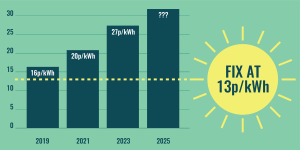Another energy price rise! When will this ever end?
Removing the smoke & mirrors around the ‘energy price cap’
Don’t be fooled by the name. Whilst the government calls it a ‘cap’, energy prices are on the rise. With a 5% hike in energy prices on the previous quarter, we remove the smoke and mirrors around these changes to give you a clearer picture of what to expect in 2024 and beyond.
Plus find out how hundreds of customers took back control in 2023 with an ‘inflation free’ energy price of 13p/kWh, fixed for 25 years! That’s why 2023 saw more solar installs in the UK than any other year.
The truth about ‘the cap’
The cap doesn’t limit your total energy bill. It’s a common misconception that a ‘cap’ sets a limit on your total energy bill – this is not the case. The energy cap only limits the price of a unit (kWh) of energy. The more units of energy you use, the more you will pay.
You could still pay above the outlined Cap. Ogfem outline the capped unit cost at 28.6p/ kWh from 1 January 2024 for a ‘typical household’. However factors including the tariff you’re on, how you pay for your energy and where you live could see you paying above this cap.
If you’re on a fixed-term energy tariff at a higher rate than the energy price cap, your tariff will not be adjusted down. It may be worth checking with your energy supplier to see if there are any exit fees and how easy it will be to move to their default tariff.
Jump To: Fix Your Energy Price at 13p/kWh for the next 25 years’
What are the loopholes used by energy suppliers to get around the price cap?
The energy price cap increase will affect the 68% of homeowners on a default energy tariff (also known as a ‘standard variable tariff’). The price cap increase will apply to you if:
- you’re on a default tariff (standard/default is energy supplier speak for ‘most expensive’)
- your fixed-term energy tariff expires and you don’t switch in time
- your previous energy supplier has gone bust
- you’ve moved home
All other tariffs are uncapped.
You’re also charged a daily standing charge regardless of how much energy you use. The average cost of remaining connected to the grid between 1 January and 31 March 2024 is 53 pence. On average you’ll pay £303 a year on these standard charges before a single unit of energy is used!
Solar owners shop around to benefit from an energy tariff with a lower standing charge and higher energy (kWh) cost, with peace of mind that the majority of their energy comes from their Solar reducing their exposure to volatile grid energy costs.
Jump To: ‘Fix Your Energy Price at 13p/kWh for the next 25 years’
How much will the energy price cap impact me?
This is the big question. Let’s take a look.
Energy regulator Ofgem outlines the below as a baseline figure:
“From 1 January 2024, the price for energy in a typical household for gas and electricity by direct debit will go up by £94. This will take the price cap from £1,834 to £1,928 per year“.
Your standing charges and unit rates under the price cap will also vary based where you live and how you pay for your energy – get the breakdown here.
Quick facts about the energy price cap
- On average, homeowners can expect to pay £28 more on their monthly energy bill in January 2024 compared with January 2023.
- Energy regulators Ofgem review and adjust the energy cap accordingly each quarter, with further adjustments coming from 1 April 2024.
- Forecasters’ opinions are divided on whether they’ll go up or down, but the general trend for long term energy prices is clearly up.
How secure are energy prices in the future?
With the general election widely reported to be happening in the second half of 2024, the current Government are unlikely to reduce the £40 billion that tax payers spend subsidisng energy bills each year as this would put bills up, and that’s a vote loser.
But with such a large tax deficit from COVID, it’s an easy subsidy for the next Government to reduce early in their term to bring down Government debt. We expect that whoever is in power will carry on gradually clawing back this subsidy, which will lead to an increase in energy bills. Otherwise the opposition will likely argue that Working Tax Payers are disproportionately subsidising high users of energy.
Fix your energy at 13p/kWh for at least 25 years…

In 1999 electric was 8p/kWh. Would you like to have forward-brought your electric for the next 25 years in 1999 at that price? Now is your chance to get energy security for at least 25 years with Solar PV!
Thousands of customers have already futureproofed themselves, reducing exposure to future energy price rises by embracing Solar as an ‘inflation free’ energy solution.
A Solar PV system installed today can be expected to last much longer than 25 years. (Dividing the installation price by the amount of kWh generated in that time gives a price per kWh figure). The data from our highly accurate PV Sol software shows that from nearly 4000 bespoke Solar PV quotes our design team prepared in 2023, the average price from Solar is just 13p/kWh!
We’re seeing our Solar PV systems vastly outperform degradation levels, and with companies like Sunpower offering an industry leading 40-year warranty that also covers replacement costs, we’re confident that 25 years is a conservative forecast.
Clean up in two ways
And it’s not just your monthly energy bills Solar PV tackles head on. You can also feel great about slashing your carbon footprint and living a more sustainable life in the battle against climate change.
Take the first step to energy security today and get your free Solar PV quote.

